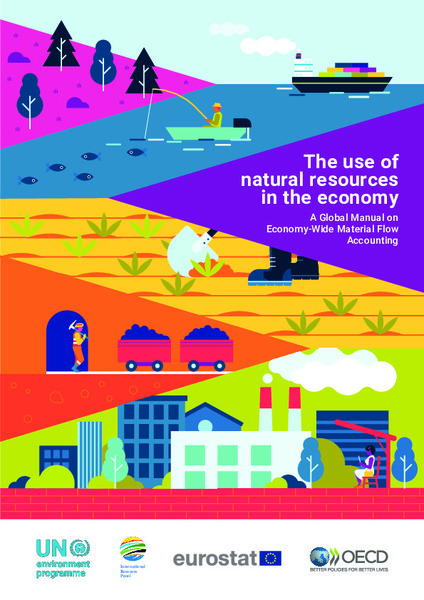| dc.contributor | Science Division | en_US |
| dc.contributor.author | United Nations Environment Programme | en_US |
| dc.contributor.other | Schandl, Heinz | en_US |
| dc.contributor.other | West, James | en_US |
| dc.contributor.other | Lutter, Stephan | en_US |
| dc.contributor.other | Eisenmenger, Nina | en_US |
| dc.contributor.other | Miatto, Alessio | en_US |
| dc.contributor.other | Linster, Myriam | en_US |
| dc.date.accessioned | 2021-06-03T06:08:25Z | |
| dc.date.available | 2021-06-03T06:08:25Z | |
| dc.date.issued | 2023-05 | |
| dc.identifier.isbn | 978-92-807-3858-2 | en_US |
| dc.identifier.other | DEW/2356/NA | en_US |
| dc.identifier.uri | https://wedocs.unep.org/20.500.11822/36253 | |
| dc.description | MFA data sets and indicators are part of the work programme of a growing number of national statistical offices globally and the global application of EW-MFA accounts in national statistics, beyond Europe, has required the creation of a global guidance manual. This global EW-MFA manual builds on the experience and excellence of the Eurostat accounting guidelines but extends them in several important ways. The global EW-MFA manual:
• presents a modular approach to EW-MFA accounting to allow national statistical offices with different levels of capability in accounting to establish the accounts • addresses specific issues of resource-extractive economies and subsistence economic activities which are more prevalent in developing countries • favours practicality before detail and focuses on such methods that allow statisticians to capture the important aspects of material throughput in their economy • also aims to establish a connection between the EW-MFA accounts established, and the environmental and economic policy questions that can be informed by using EW-MFA based data sets and indicators.
The global EW-MFA manual is structured into eight chapters. • Chapter 1 focuses on general accounting principles, the relationship to other accounting systems; it describes common data sources for EW-MFA accounts and introduces the main structure of the manual.
• Chapter 2 presents the core of any EW-MFA account, namely the domestic extraction of materials – biomass, fossil fuels, metal ores, and non-metallic minerals. • Chapter 3 describes the accounting principles and specific issues that occur when establishing material accounts for the trade of goods. • Chapter 4 focuses on material outflows (from the economy to the environment) such as e.g. waste disposal and emissions and builds a bridge to important environmental policy issues of pollution and toxicity. • Chapter 5 integrates the input and output sides of EW-MFA accounts in a material flow balance. • Chapter 6 presents headline indicators from EWMFA accounts which are most commonly used by the policy community. • Chapters 7 and 8 discuss additional aspects of EW-MFA: material footprint accounts and material stock accounts. The accounting methods for these are, however, not covered in any detail in this edition of the manual. | en_US |
| dc.format | Text | en_US |
| dc.language | English | en_US |
| dc.rights | Public | en_US |
| dc.subject | accounting | en_US |
| dc.subject | environmental accounting | en_US |
| dc.subject | biomass | en_US |
| dc.subject | metal | en_US |
| dc.subject | material | en_US |
| dc.subject | fossil fuel | en_US |
| dc.subject | data bank | en_US |
| dc.subject | emission inventory | en_US |
| dc.subject | waste | en_US |
| dc.subject | environmental indicator | en_US |
| dc.subject | material flow | en_US |
| dc.subject | sustainable consumption | en_US |
| dc.subject | stock | en_US |
| dc.subject | natural resource | en_US |
| dc.subject | productivity | en_US |
| dc.title | The Use of Natural Resources in the Economy: A Global Manual on Economy Wide Material Flow Accounting | en_US |
| dc.type | Publications | en_US |
| dc.type | Technical Guidelines or Manuals | en_US |
| wd.identifier.sdg | SDG 8 - Decent Work and Economic Growth | en_US |
| wd.identifier.sdg | SDG 12 - Responsible Consumption and Production | en_US |
| wd.topics | Environment under review | en_US |
| wd.topics | Resource Efficiency | en_US |
| wd.identifier.pagesnumber | 156 pages | en_US |






